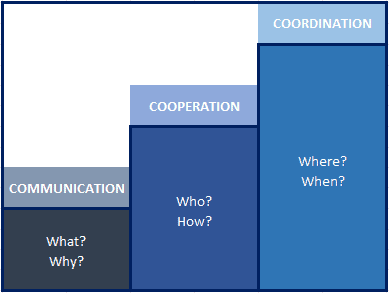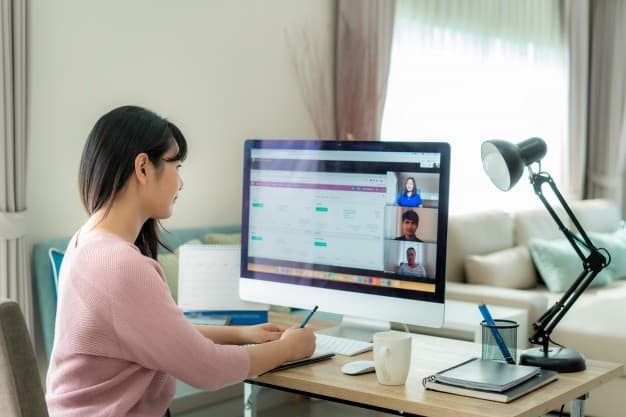|
Listen to Post
|
Listen to this article now:
Why it is so hard to break-free from the office working setting
While 2019 was the year of “climate emergency”, voted as word of the year for 2019 by Oxford Languages, “remote work” does probably already qualify as a fitting successor for 2020.
Global Workplace Analytics had forecast upward trends in remote work for the years to come, but despite the increasing preferences for flexible working arrangements, the percentage of remote workers in the EU remained very low according to Eurostat especially for employed staff.
Remote work has been the new kid on the block for more than a decade, and despite the number of remote workers ballooning in recent years, the traditional office setting remains the dominant reality for the vast majority of companies and workforce.
Where does this resistance to change stem from?
The answer lies in our brains!
There are two processing modes in which our brains can perceive what happens around us; the top-down, where our background knowledge guides our perception, and the bottom-up, where a stimulus influences our perception (here’s a nice explanatory video).
Top-down processing; an obstacle to adopting a fully remote work scenario
The stimuli we receive every second by our environments through our senses are so many that we need a filtering mechanism in place to cope with all the incoming information. Top-down processing enables us to perceive things according to our pre-conceived expectations and based on the context in which they appear every time.
Functioning on a top-down mode allows us to shortcut the cognitive processing that takes place between our perceptions and their interpretation. We heavily depend on patterns to speed up this process, and patterns are indeed useful as they help us predict the expectations in our interactions with the world. For example, when a web designer creates a website, they would put the language selector at the upper right corner, because this is the expectation users would have as part of their preconceived knowledge and given the context, namely that this is a website. If this was placed in a different location, users would be lost, and user experience would not be optimal.
Nevertheless, patterns also cause a major break-down in communication when they are not met.
Our brain has been dealing with specific patterns of professional environments and home environments throughout our entire life. Like in the Cornsweet Illusion, where we would expect that the apparent difference would disappear when we remove our finger, but it doesn’t, we will go through a resistance in all the changes that remote working is bringing, simply because our brains are too stubborn to admit that their predictions are inaccurate.
Trivial: For the linguists and translators reading this, it has been demonstrated that the top-down approach also applies in reading and letter identification. That’s probably why we cannot see the typos in our own work especially when we’ve read a text many times, and that’s where a separate set of eyes, those of a reviewer or an editor, always comes in handy.
Our knowledge is limited and biased in certain ways. When we apply our knowledge to our perceptions, it similarly limits and biases our perceptions.
Bottom-up processing to the rescue
What does that do to our perception when we need to respond to emergency scenarios, to situations that we have never dealt with before?
Well, we unavoidably switch to a bottom-up approach in order to start creating this knowledge by processing data we have not come across before while interpreting it outside of any contextual clues.
While this process is in play, we can navigate through the new situation more effectively by adopting the Triple C model used in emergency response training and in project management.
After all, if the complete enforcement of remote working due to the COVID-19 lockdown does not qualify as an emergency, what does?

Steps of Triple C model from managing emergency response
We need to start with the specifics, interpret our new context and frame this perception in order to be able to recall it in a top-down approach in the future.
Remote work; which contexts change and how
Our everydayness is structured around different contexts, the physical, the temporal, and the socio-psychological, and our brains respond to those contexts to perceive and interpret the stimuli. Switching from an office working setting to a home working setting, these contexts change drastically. Here is what we need to prepare our brains for in order to be able to better adjust to our new working setup.
Physical context
What changes: There is no office space anymore. The space where work takes place is now blending with our personal space, our home, and there is no guarantee that this is distraction-free throughout our working day. Another big change that relates to that shift in our physical context and with communication shifting from a walk over to someone’s desk to a virtual call is that our personal setting is now exposed to another group of people, our colleagues, whom we did not use to necessarily socialize with on a personal level.
What we can do: We can tackle this by specifying a working space in the house depending on the exposure level we want to allow and the access to distractions we can handle.
Temporal context
What changes: There are two aspects here to examine. One is that while our working hours typically remain unchanged, the actual time we work remains unknown. As already mentioned before, our house is a distraction-full environment and our roles, while working from home on a full-time basis, are confused. Especially in situations where other family members are at home during our working hours and require one way or the other our attention. The other is that we may have a hard time disengaging from our work, and this is also reinforced by the fact that we use the same tool for both our professional and our personal profiles, our computer.
What we can do: When it comes to the first point, knowing the different limitations we will have throughout the day, we can try to adjust our working day accordingly, either by starting earlier in the morning or by finishing later in the afternoon to accommodate for the time-off during the day. This however affects our availability and response times when it comes to our communication with the rest of the team, and thus expectations need to be communicated and agreed upon accordingly. As for the second one, we can work on a task list per day. Production-focused jobs are easier to frame as they depend on the incoming requests or a standard output, while operations-oriented positions may be challenged more as it is rather tempting to work longer on projects spanning days or weeks. In any case, we can try to set a (sub)task list per day or week, and work on that turning off the computer when completing it.
Socio-psychological context
What changes: When working remotely for an extended period of time, we lack the physical interaction and all face-to-face communication. Body language and facial expressions are no longer in play, thus our emotional intelligence might be underused in those situations. Also, while spoken communication acquires a written, yet informal, form, our acquired interpretation pattern of our professional communication is broken as it resembles more and more our communication patterns with friends and family. In that mode, given that many enterprises also have to deal with different cultural conventions as their activities spread across many countries, and daily operations are handled by cross-cultural teams spread out across the globe, our brain is called upon to dismiss what constitutes previous knowledge.
What we can do: Where a lower register used to be appropriate, we can change to a neutral one, to ensure that our message is more informative than colloquial and as such is better and faster conveyed. This will also tackle any cultural diversity amongst global teams. Efficiency of communication is our main aim as it will facilitate our everydayness. However, don’t forget the watercooler chit-chat, where you can freely and guilt-free make use of emojis, gifs and the such to express your feelings and unwind. Just because we are working on different locations, it does not mean we cannot bond.
Dismissing the misconceptions on remote work
What makes us process our everydayness faster and smoother is what limits and biases our perception when it comes to change. Bypassing some steps of bottom-up processing and offering our brains an initial framework for the new situation, we can dismiss existing misconceptions and adjust to the new reality faster and with less stress.
Remote working may not be everyone’s cup of tea (or coffee!), but there are many benefits to it. The least it deserves is objective consideration.









